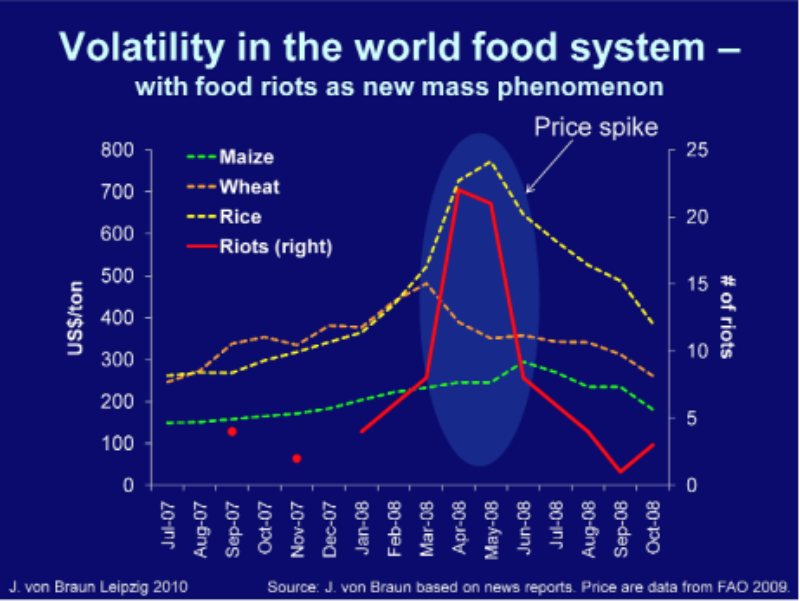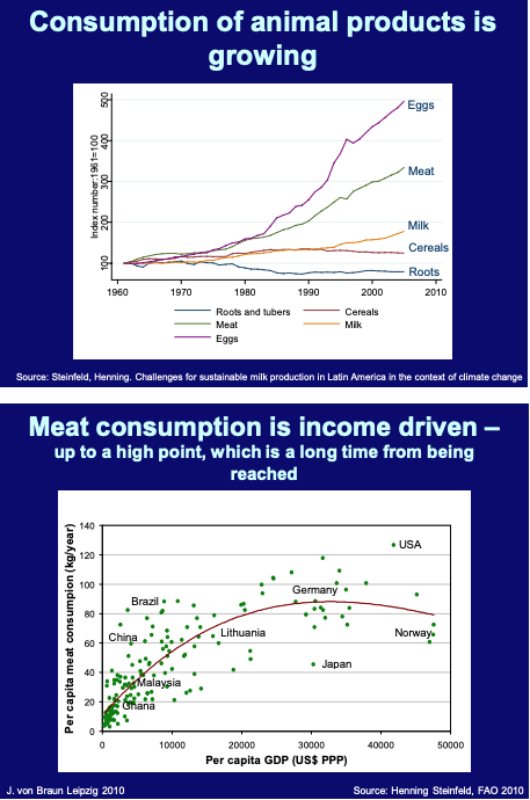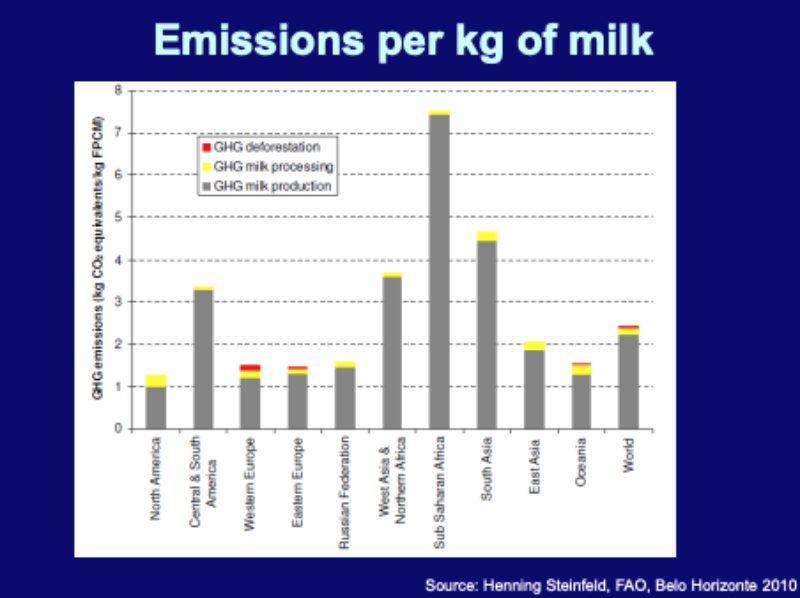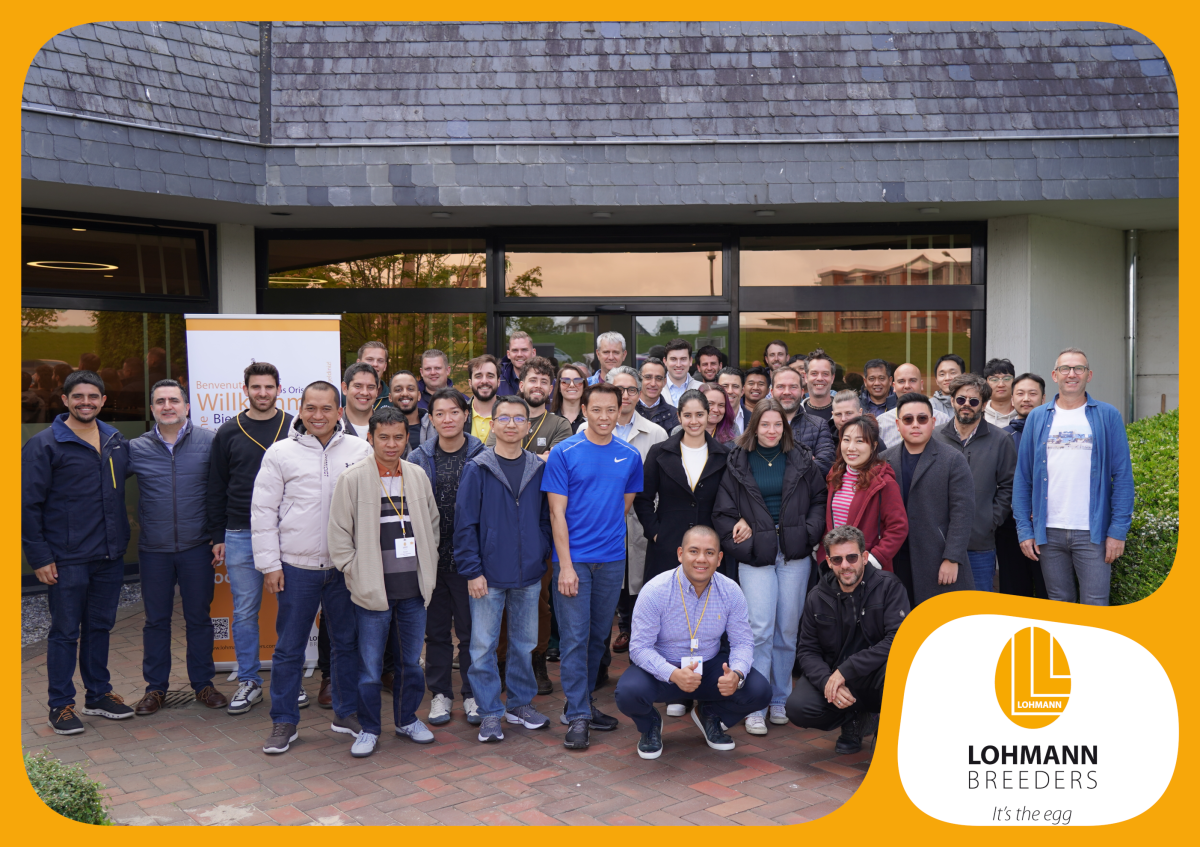Introduction
The science which the participants of this World Congress on Genetics Applied to Livestock Production engage in and the science frontiers they are pushing forward are extremely important to the wellbeing of mankind. Innovative breeding and reproductive technologies in livestock production are as fundamental for global food security as is plant breeding.This presentation will cover population concerns and food insecurity; production and income issues; consumption; health and nutrition; environment, and the required policy action. As this is a rather wide-ranging set of issues I offer you my two main conclusions:
– a strategy for the global livestock economy that serves world food security requires new technology and adapted consumption behavior and – a big push to enhance livestock productivity is needed for global food and nutrition security.
Populations
The world population of 2050 will be roughly nine billion. The good news is there will probably be not more than nine billion, but they will eat like twelve billion people would eat today. The human population has more than doubled since 1960. Some domestic animal populations, however, grew more rapidly than people did (figure 1). The World chicken population quintupled since 1960, and is predicted to increase further from currently 19 billion to at least 30 billion by 2015. Numbers of pigs and goats roughly kept up with human population growth, whereas cattle and sheep populations have grown less in numbers than people. There will not only be more people on the globe, but they will also be more urban and they will be
richer and they will demand more water- and land-intensive foods, such as meat, milk and fish. At
the same time, it is depressing news that in the last few years hunger has further increased in the
world. The absolute number and, in the last two years, even the relative proportions of hungry people
have risen. According to recent FAO estimates, the number of undernourished people is about one
billion. This estimate refers only to calorie-deficient nutrition, a much larger number suffers from protein
and micronutrient-deficiency.
There will not only be more people on the globe, but they will also be more urban and they will be
richer and they will demand more water- and land-intensive foods, such as meat, milk and fish. At
the same time, it is depressing news that in the last few years hunger has further increased in the
world. The absolute number and, in the last two years, even the relative proportions of hungry people
have risen. According to recent FAO estimates, the number of undernourished people is about one
billion. This estimate refers only to calorie-deficient nutrition, a much larger number suffers from protein
and micronutrient-deficiency.
Volatility
The world food system has become more unstable, volatility is an issue that affects all aspects of the agricultural market and production systems. The following graph 2 illustrates that fact through the ups and downs of prices which have occurred over the last two to three years.
The price spikes of 2008 are well remembered in the animal production community. People suffered but also livestock producers suffered because feed was becoming so expensive. The food crisis multiplied the number of poor and hungry people in low income countries. But something in addition happened: as shown in the graph, the frequency of protest, some of them quite violent, increased around the world in the context of the world food price crisis. There were more than 60 such events and several governments toppled over the protests. People don´t put up with an unstable world food system anymore.
Production
Livestock and its inputs are a growing economic sector. The livelihood and income effects of the livestock economy are huge. More than a billion people keep livestock, 60% of rural households do so. It’s a major income source of the poor and especially of women in developing countries. The dairy industry in particular, plays a strong role for the livelihood of poor people. The livestock capital as part of the overall agricultural capital amounts to more than a quarter. Land valued at market prices is about half. Livestock capital is therefore a very important element of the overall capital stock of world agriculture.
Meat production is growing fast, especially in the countries of East and Southeast Asia. The growth rates are exponential. Latin America, the Caribbean, and Brazil also play an important role and show a very significant growth in meat production. Milk production did not grow quite so fast. It is mainly India, which drives that global supply upward.
Graphs 3 and 4: Growing production of meat and milk

There is a lot of debate about the relationship between animal production and water. Some of the debate is rather simplistic, discussing only the water footprint, the virtual use of water through the livestock sector. It is necessary to look deeper into the issue. The implicit use of water for animal production is indeed significant and as climate change will make water availability an increasing problem, the whole livestock production sector needs to become more water-efficient, especially in the world’s dry zones. Water availability will change regional comparative advantages even more than in the past.
Genetic Resources
Among the inputs of the livestock economy the genetic resource base is a key one. It’s of great value, but assessing that value is not straight forward. First, there is its market value; second, genetic traits have an insurance value (to fend off future risks); third, it also has an intrinsic inheritance value (preserving traditional breeds, developed by our ancestors). The national ownership of the genetic resources is protected by general international law but with it comes responsibility for conservation and for sharing. This Congress includes a session which follows up on the International Conference in 2007 on livestock genetic resources, organized by FAO, which plays a crucial role in that respect.Demand
Demand drives the growth of the livestock sector. Not only in the livestock production domains, but generally in agriculture the world is currently in the middle of a paradigm change. Already, many countries shift from a market- and commodity-oriented sector to a food systems concept. Agriculture moves from being supply-driven to a demand-driven sector – focusing on serving consumers, and anticipating what consumers will want in the future. In the context of that paradigm change, agriculture will turn toward a broader concept of “bio-economy”. Bio-economy is the cross-cutting economic sector that embraces all the different bio-based raw materials and conversions from biomass to other highly valued materials.
The animal genetic research community will also become more demand-driven and bio-economy oriented in the future. The consumption of animal products will be driven by changes in population size, available family income, relative food prices, taste and preferences. The transformation from traditional markets to complex food systems will continue, not only in developed countries. The consumption curves for the major world food items depicted in graph 5 show a steep upward trend, especially for eggs, meat, gentler for milk. These trends are in contrast with the basic staple foods which are shown at the bottom of the graph, the cereals, the roots and tubers, and potatoes. Animal production is really in the high -growth segment of the world food system compared to the staple food sector. Meat consumption per capita is also approaching similar levels across the world.
As illustrated in graph 6, where per capita meat consumption is plotted against per capita income for different countries, meat consumption is income-driven up to a very high point and the world is far from reaching that point. One can guess how long it will take to reach that income level. The desired meat consumption – given today’s consumption behavior – will require at least a doubling of per capita meat supply once the world has reached these income levels, which may happen within this century.
Consumer reaction to increasing meat prices is generally strong. A recent review looking across more than 400 studies of the price elasticity of meat shows that a 1% increase in prices presses meat demand down by 0.5 %. That’s a very important issue to keep in mind because pricing and taxation of meat would reduce demand. If we run into supply constraints and prices go up, consumers will react promptly and the poor will have to respond stronger with consumption reduction than the rich, because of income constraints.
Taste
Eating meat and drinking milk has deep roots in human evolution and culture. The question if people will change their taste is a very important one for the sustainability of the livestock economy and of the agricultural system. An interesting fact is that over the last few decades the prices of fruits, vegetables and bakery products, especially of fruits, vegetables and pulses, have increased more than for animal products. So, relatively speaking, animal food has become cheaper. Therefore, consumers shift more and more to animal products, which may lead to obesity and health problems. There has been a lively debate among policy makers and economists about how to correct this problem. Price policy, for instance a meat tax, and a fat tax, have been discussed, for instance at the World Health Organization.The diversity of taste is still large: For more than a billion people consumption of pig meat is forbidden, but in the Chinese language pig means home, and pig meat is happily consumed if the price is right.
Around the world different attitudes drive human behavior and are enshrined in their culture. Apparently it is easier to increase the efficiency of animal production than to change consumption behavior.
Graph 5: Increasing consumption of animal products, compared to cereals and roots

People´s and Animal’s Health
People´s and animals´ health are linked and must improve together. These are complex issues. They call for more research on zoonotic diseases, antibiotic resistance, excess consumption of livestock products, and children’s nutrition and meat consumption. Regarding the latter issue, there is some exciting new research from the nutrition community: Animals contribute not only significant shares of calories but also of healthy diet ingredients to human consumption, and there is a connection between meat and children’s diet which helps to improve cognitive function and initiative.Results of the first randomized trial on the effects of incremental meat consumption among school children in twelve schools in Kenya are published by Neumann et al (2007) in the Journal of Nutrition (J. Nutr.137:1119–1123, 2007). All children received the same calories, but the composition of their diet was different to compare the effects of supplementation with either more milk or more meat or more fat. The meat group showed the steepest increase in cognitive functions, in learning abilities and achievements. The meat group also showed the largest nutritional impact on the children with respect to the time they were able to spend on high-level physical activity and on their leadership behavior. There is something to meat which is difficult to substitute, a calorie is not a calorie; a protein is not a protein. When talking about meat and health one must not only look at the downsides of excessive meat consumption but also at the upside of increased shares of meat in the diets of the poor.
Environmental Footprints
The environmental and greenhouse gas footprints in the context of livestock production need to be addressed too. Climate change and greenhouse gases make matters more complex when developing an efficient and sustainable strategy for the animal production sector. Ways must be found to reduce livestock emissions along the whole food value chain, not just a trick here or there. Emissions from feed production, emissions from livestock rearing and from processing and transport should be decreased significantly. A particularly important aspect is the emissions from feed production, namely the indirect land use effects of the animal production sector, pushing at rainforest use and conversion of pastures.Of prime importance, however, is productivity. Comparing the greenhouse gas emission per kg of milk, in Western Europe with Sub-Saharan Africa and South Asia, shows that productivity and efficiency increases are environment-friendly, which is often overlooked (see graph 7 below).
Ethics
Consumers are demanding and not always easy to please when it comes to food quality. Global consumers of animal products want their food to be: (1) affordable, (2) healthy, (3) nutritious, (4) safe, (5) environmentally friendly, (6) culturally acceptable and (7) fair to the animals. Rich and poor consumers value each of these criteria differently. Animal production therefore needs to pay attention to ethics, economics, science, and communication. Ethics in food and agriculture must facilitate actions to end hunger and malnutrition of people, but it must also respect the wellbeing of the animals.Animal science must engage in two ethical problems. First, when there is no general understanding of what is ethical then it is largely a communications and awareness issue to inform people. Secondly, when there are recognized ethical principles and they are violated, it is an issue of regulations and law. Not all what is scientifically feasible is accepted as ethical, and perhaps the professional community of animal geneticists can learn from the medical profession in ethical issues.

Conclusions
What happens if the science and research investments in agriculture are stagnating? The sad answer is: food and nutrition security will deteriorate further. The science of animal production must continue to push at frontiers in animal genetics: design of breeding programs, genotype-environment interaction, genomic selection, disease resistance and support animal welfare – productivity related tradeoffs. Research on synthetic and hybrid meat and milk products should also be on the agenda. Innovative and new technologies are required in animal production, and communicating the advantages of innovations to farmers and consumers must be an integral part of this. More cooperation among scientists, media, and policy makers is needed to make science communication more effective – not propagandistic advocacy of pro or against innovation.A strategy for the global livestock economy serving food security requires new technology and changing consumption behavior. A big push to enhance livestock productivity for global food and nutrition security is needed now.
Zusammenfassung
Die Rolle der Tierproduktion für die wachsende WeltbevölkerungDie Weltbevölkerung nimmt weiter zu und dürfte im Jahre 2050 etwa 9 Milliarden erreichen. Die Zunahme findet hauptsächlich in Entwicklungsländern statt, wo die gleichzeitig steigende Kaufkraft einer wachsenden Mittelschicht auch die Konsumgewohnheiten verändert. Nimmt man beide Faktoren zusammen, so entspricht der zu erwartende Fleischkonsum dann 12 Milliarden Menschen mit heutigem Durchschnittsverbrauch. Entsprechend muss die Tierproduktion ausgeweitet werden, um dieser Nachfrage gerecht zu werden. Die damit verbundenen Risiken für die Umwelt und die Gesundheit von Menschen und Tieren sind eine Herausforderung für die Wissenschaft und Praxis der Tierproduktion.
Die Produktivität der Tierproduktion hat in den zurückliegenden Jahrzehnten stark zugenommen, sowohl hinsichtlich gesteigerter Leistungen pro Tier wie auch in einer Senkung der Produktionskosten, z.B. in der Milchleistung je Kuh und verbesserter Futterverwertung bei Schweinen und Geflügel. Die Konkurrenz zwischen Tierfutter und Pflanzennahrung für den Menschen wird weiter verschärft durch die Nutzung von Biomasse zur Energiegewinnung.
Die Beherrschung von Gesundheitsrisiken in Tierpopulationen, die globale Kontrolle zoonotischer Erreger und die Minimierung von Rückständen in Nahrungsmitteln tierischen Ursprungs dürften an Bedeutung gewinnen. Klimaveränderungen durch Treibhausgasemissionen von zunehmenden Tierbeständen und geänderter Bodennutzung müssen vermehrt beachtet werden. Gleichzeitig wird der Tierschutz eine größere Rolle spielen und herkömmliche Produktionsmethoden in Frage stellen. Effizientere Tierproduktion bedeutet in aller Regel weniger Umweltbelastung, und moderne Produktionsverfahren bieten höhere Standards für die Sicherheit von Lebensmitteln und Tiergesundheit. Die Vielfalt der Produktionssysteme ist eine gute Voraussetzung für die weitere Entwicklung. Die Tierhaltung trägt maßgeblich zur Verbesserung der Lebensqualität für die Landbevölkerung in Entwicklungsländern bei. Rund eine Milliarde Menschen halten Tiere, und für 60% der ländlichen Haushalte ist der Verkauf von Tierprodukten eine wichtige Einkommensquelle.







